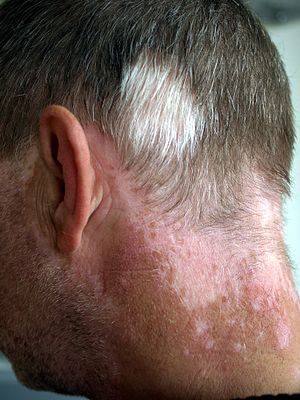Poliosis
| Poliosis | |
|---|---|
 | |
| Depigmentation of sections of skin and hair in 48-year-old man with vitiligo and poliosis. | |
| Specialty | Dermatology |
Poliosis (also called poliosis circumscripta), is the decrease or absence of melanin (or colour) in head hair, eyebrows, eyelashes or any other hairy area. It is popularly known as white forelock when it affects hair directly above the forehead.
This condition can cause single or, less commonly, multiple white patches on the hair. Some mistake these white patches for simple birth marks. In poliosis there is decreased or absent melanin in the hair bulbs of affected hair follicles; the melanocytes of the skin are usually not affected.[1]
Associated medical conditions[]
Poliosis occurs in several genetic syndromes such as piebaldism, Waardenburg syndrome, neurofibromatosis type I, and tuberous sclerosis.[2] It can also occur in conditions such as vitiligo, Vogt–Koyanagi–Harada disease, alopecia areata, sarcoidosis, and in association with neoplasms and some medications.[1]
Popular culture[]
It is sometimes called a Mallen streak, after a fictional family with hereditary poliosis. The Mallen family featured in a sequence of novels by Catherine Cookson, of which The Mallen Streak was the first. She later adapted them into a TV series called The Mallens.
Sports presenter Dickie Davies, runner Sam Brown, punk singer Dave Vanian, and fashion expert Stacy London are also known for their Mallen streaks.
During his tenure as the host of Talk Soup, host John Henson repeatedly referred to his own poliosis as a "skunk spot".
In DC Comics one of Batman's Robins, Jason Todd, is sometimes portrayed with a white forelock.
Cruella De Vil is thought of to have this condition with her half black / half white hair.
The main character of the Satan 666 manga series seems to have the condition
During his Christmas special, Jeff Dunham was doing a bit with Achmed the Dead Terrorist and mistakenly combined scoliosis with polio, making poliosis.
References[]
- ^ a b Sleiman R, Kurban M, Succaria F, Abbas O (2013). "Poliosis circumscripta: overview and underlying causes". J Am Acad Dermatol. 69 (4): 625–33. doi:10.1016/j.jaad.2013.05.022. PMID 23850259.}
- ^ Willacy H. (2010). "Tuberous Sclerosis". PatientPlus. Patient.info. Retrieved May 2, 2011.
External links[]
- Human hair color
- Dermatologic terminology
- Cutaneous condition stubs